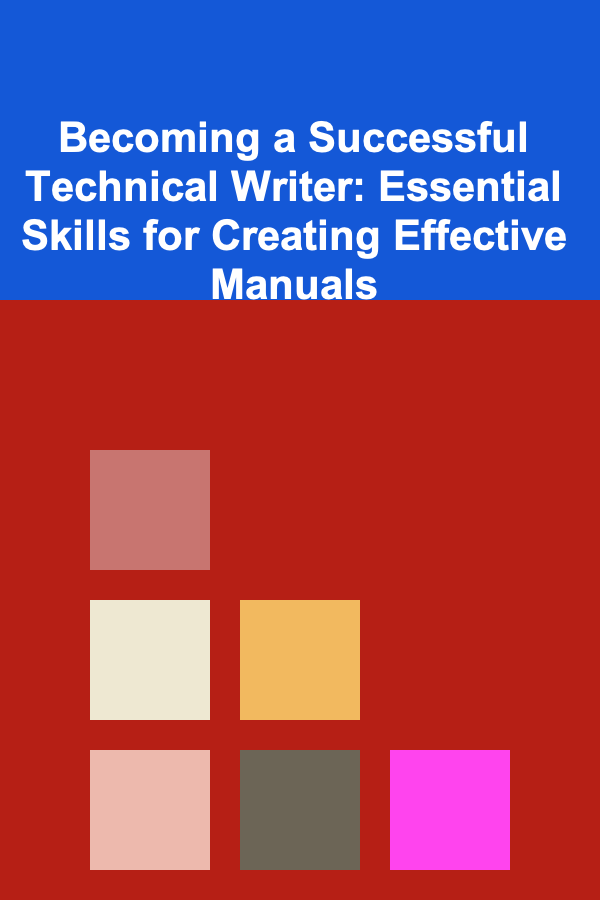
Becoming a Successful Technical Writer: Essential Skills for Creating Effective Manuals
ebook include PDF & Audio bundle (Micro Guide)
$12.99$8.99
Limited Time Offer! Order within the next:

Technical writing is an art and science that requires a unique blend of skills. It demands the ability to understand complex information and communicate it in a way that is clear, concise, and user-friendly. As technical writers, the goal is not just to create manuals, but to ensure that users can easily understand and apply the information provided.
Whether you're a seasoned technical writer or just starting, this actionable guide will outline the essential skills needed to become a successful technical writer and create manuals that are effective, clear, and helpful.
Strong Understanding of the Subject Matter
One of the most crucial skills for a technical writer is a strong understanding of the subject matter they're writing about. This doesn't mean you need to be an expert, but you must be able to comprehend the technical details and translate them into language that users can understand.
Key Actions:
- Collaborate with Subject Matter Experts (SMEs): If you're writing about complex technical topics, regularly communicate with engineers, developers, or other SMEs to ensure accuracy.
- Do Thorough Research: Conduct extensive research to gather all necessary details. If there are parts of the subject that are unclear, don't hesitate to ask for clarification.
- Understand the Target Audience: Know the level of technical expertise of your readers. The more you know about their background, the more effectively you can tailor the content.
Clear and Concise Writing
The primary goal of a technical manual is to explain processes or instructions in a way that is as clear and straightforward as possible. The writing must be precise, avoiding ambiguity while being easily understood by the intended audience.
Key Actions:
- Avoid Jargon: Unless your audience is highly technical, avoid using industry jargon or overly complex terminology. Use simple, plain language whenever possible.
- Use Active Voice: Active voice is direct and easier to understand than passive voice. For example, "Click the button" is clearer than "The button should be clicked."
- Keep Sentences Short and Simple: Long, complex sentences can confuse readers. Aim for clarity by keeping sentences to the point.
- Organize Information Logically: Ensure that information flows in a logical sequence, with each section building upon the previous one.
Effective Document Design
The design and structure of your manual are as important as the content itself. A well-structured document is easier for readers to navigate and find the information they need.
Key Actions:
- Use Headings and Subheadings: Break your content into digestible sections using headings and subheadings. This makes it easier for users to scan and locate specific information quickly.
- Incorporate Lists and Bullet Points: Lists and bullet points simplify complex information, making it easier for readers to follow instructions step-by-step.
- Provide Visual Aids: Diagrams, screenshots, flowcharts, and videos can help explain complex processes that may be difficult to convey with text alone.
- Consistent Layout and Formatting: A consistent layout and formatting style help improve readability. Use the same font types, sizes, and heading styles throughout the document.
Attention to Detail
Technical writing requires precision. Even small errors in a manual can cause confusion or lead to misinterpretations. It's crucial to pay attention to every detail, from terminology to formatting, and ensure everything is accurate.
Key Actions:
- Proofread Your Work: Always proofread your documents before publishing them. Check for grammatical errors, spelling mistakes, and inconsistencies.
- Verify Technical Accuracy: Double-check technical details, especially when it comes to instructions, steps, or measurements. An incorrect instruction can lead to serious consequences, particularly in safety-critical fields.
- Test Your Instructions: Whenever possible, follow the instructions in your manual yourself or ask someone else to follow them. This helps identify areas that might need clarification or improvement.
Understanding User Needs
Understanding the end-user is key to creating a technical manual that serves its purpose. Manuals should be designed with the user's experience in mind, addressing their potential challenges and questions.
Key Actions:
- Conduct User Research: Before you start writing, find out who your audience is, what their expertise level is, and what problems they are trying to solve.
- Create Personas: Develop user personas to better understand different types of users and their needs. These personas can guide the tone, language, and content of your manual.
- Gather Feedback: After your manual is used, gather feedback from users to understand if the manual was helpful, and identify areas for improvement.
Version Control and Updates
Manuals often need to be updated regularly to reflect changes in products, services, or processes. A successful technical writer must understand how to manage versions and keep the content current.
Key Actions:
- Track Changes: Implement a system for tracking changes to the manual. This might involve using version control software, such as Git, or simply documenting revisions in a change log.
- Regularly Review and Update Manuals: Schedule periodic reviews of your manuals to ensure that the content remains accurate and up to date.
- Maintain a Consistent Style Guide: A style guide ensures that your manuals maintain a consistent tone, formatting, and language across all versions. This is especially important if multiple writers contribute to the project.
User-Centered Design Thinking
User-centered design (UCD) is a methodology that puts the needs of the user at the forefront of the design process. In technical writing, UCD helps ensure that manuals are not only clear but also intuitive and easy to navigate.
Key Actions:
- Understand User Scenarios: Create user scenarios that show how your target audience will interact with the product. This helps you write manuals that are relevant and targeted to real-world use cases.
- Empathy for the User: Think from the user's perspective. What might confuse or frustrate them? What would make their experience easier? This empathetic approach will help you write more effective manuals.
- Provide Contextual Information: Sometimes users need information that isn't directly part of the step-by-step process, but will help them understand why they're doing something. Adding context in the form of notes or explanations can be helpful.
Collaborative Skills
Technical writing is rarely a solitary task. Often, you'll be working with a team that includes engineers, product managers, UX designers, and others. Effective collaboration ensures that your manuals are both technically accurate and user-friendly.
Key Actions:
- Communicate with SMEs: Regular communication with subject matter experts is vital. Ask questions, clarify doubts, and ensure that the technical content you're writing is accurate.
- Work Closely with Designers: Collaborating with graphic designers or UI/UX experts can help ensure that the layout and design elements of the manual are intuitive and accessible.
- Incorporate Stakeholder Feedback: Be open to feedback from various stakeholders, including internal teams and users. This input can provide valuable insights that enhance the quality of your work.
Adaptability and Continuous Learning
The field of technical writing is dynamic, with new tools, technologies, and writing techniques emerging regularly. Being adaptable and continuously seeking to improve your skills is essential for staying relevant in this field.
Key Actions:
- Learn New Tools and Technologies: Stay up to date with the latest tools for writing and document creation. Familiarize yourself with software like Adobe FrameMaker, MadCap Flare, or Microsoft Word, and learn about new technologies such as content management systems (CMS) and version control systems.
- Attend Workshops and Conferences: Participate in technical writing workshops, webinars, and conferences to expand your knowledge and network with other professionals in the field.
- Embrace New Writing Formats: As the digital landscape evolves, explore new writing formats like online help systems, interactive documentation, and multimedia-based manuals.
Conclusion
Becoming a successful technical writer requires a combination of skills that go beyond simply knowing how to write. From understanding complex technical concepts and designing user-friendly manuals to collaborating with experts and keeping your content up-to-date, technical writing is a challenging but rewarding field. By honing these essential skills, you can create manuals that not only inform but also empower users to get the most out of the products or services you're documenting. As you grow in your career, remember that continuous learning and adaptation will help you stay at the top of your game in an ever-evolving field.
Reading More From Our Other Websites
- [Home Soundproofing 101] How to Soundproof Your Walls Like a Pro
- [Screen Printing Tip 101] From Concept to Canvas: A Step-by-Step Guide to Screen Printing Your First Poster
- [Home Party Planning 101] How to Create Fun Birthday Ideas to Do at Home
- [Home Cleaning 101] How to Create a Weekly Cleaning Schedule That Works
- [Home Party Planning 101] How to Host a Themed Costume Party at Home
- [Needle Felting Tip 101] DIY Textured Home Décor: Needle-Felted Accessories to Transform Any Space
- [Organization Tip 101] How to Handle Duplicate Photos Effectively
- [Rock Climbing Tip 101] Home-Gym Hacks: Essential Equipment for Solo Climbing Workouts
- [Organization Tip 101] DIY Programmable Light Switch Installation Tips for Beginners
- [Organization Tip 101] How to Manage Seasonal Clothing with Ease

How to Choose Eco-Friendly Appliances for Your Home
Read More
How to Choose the Right Rental Property for Your Investment
Read More
How to Cut Unnecessary Expenses in Your Monthly Home Budget
Read More
How To Understand the Kingdom of Kush
Read More
Innovation Nation: How to Stand Out by Embracing Disruptive Technologies
Read More
Discovering the Role of Aromatherapy in Sleep: A Comprehensive Guide
Read MoreOther Products

How to Choose Eco-Friendly Appliances for Your Home
Read More
How to Choose the Right Rental Property for Your Investment
Read More
How to Cut Unnecessary Expenses in Your Monthly Home Budget
Read More
How To Understand the Kingdom of Kush
Read More
Innovation Nation: How to Stand Out by Embracing Disruptive Technologies
Read More